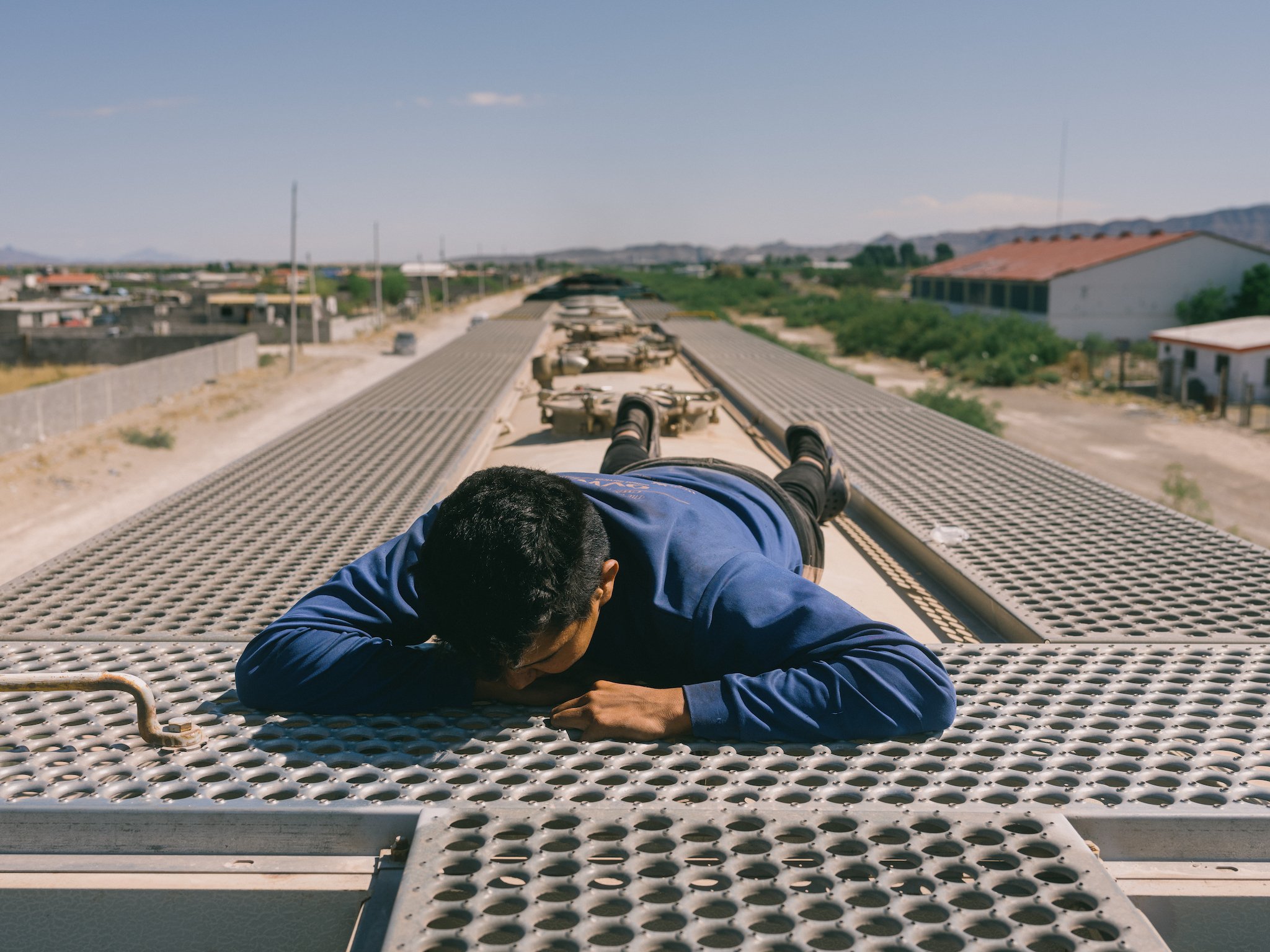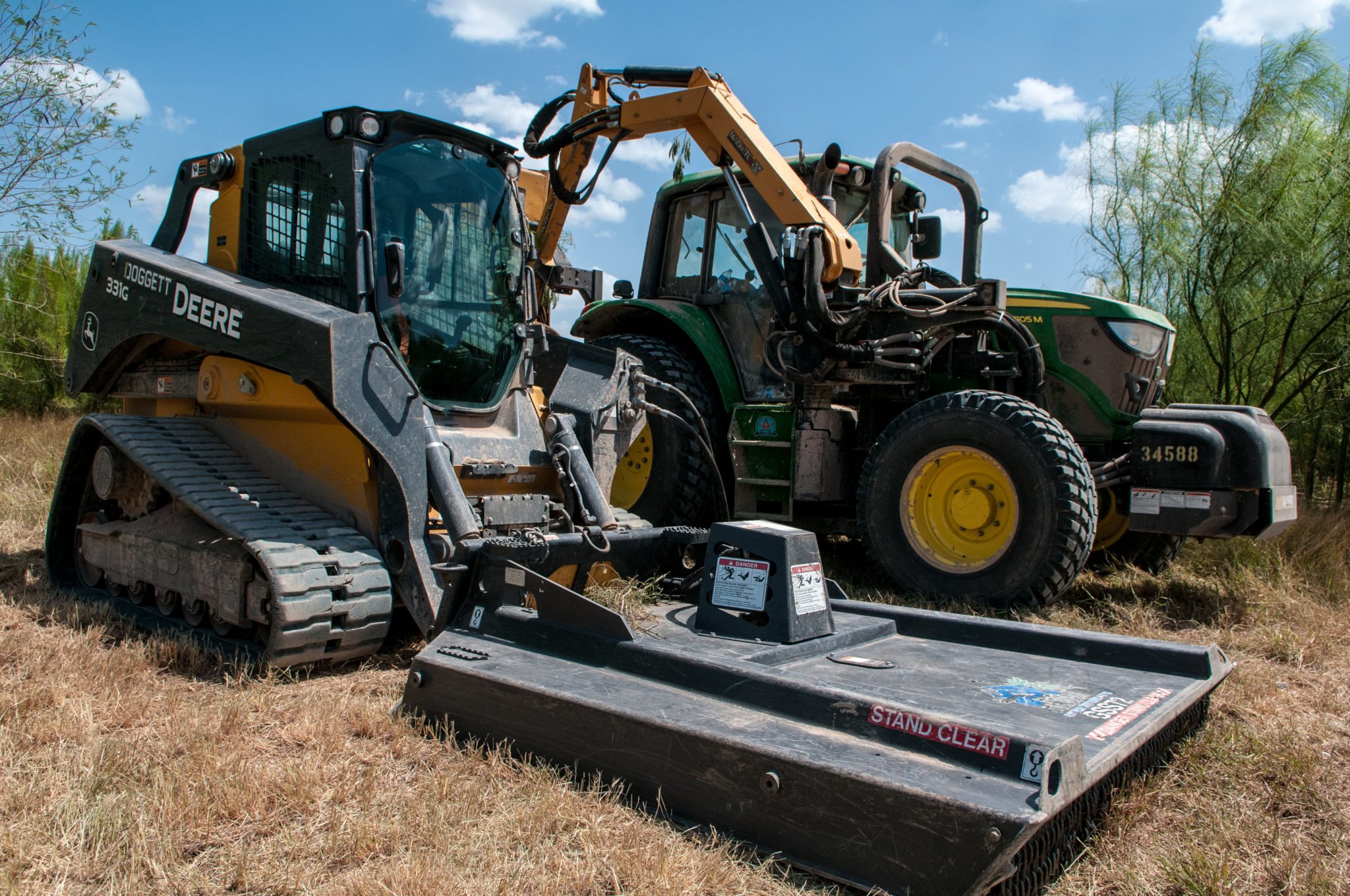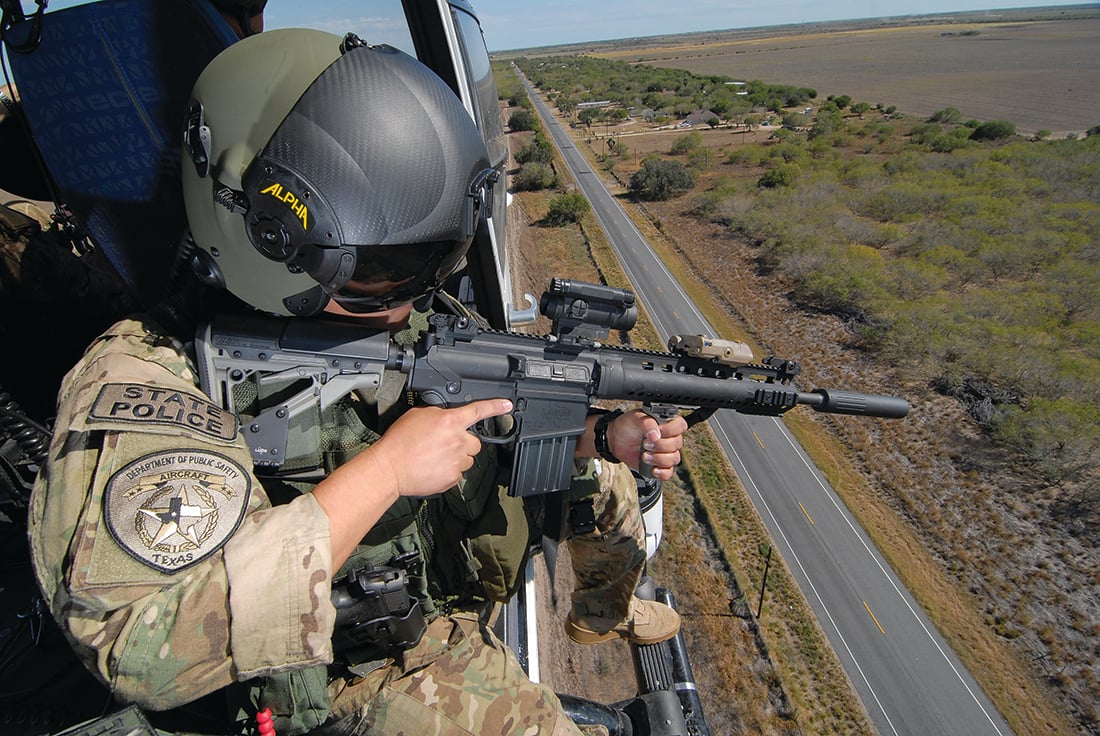
Death on Sevenmile Road
The rush to militarize the U.S.-Mexico border has tragic consequences in Texas.
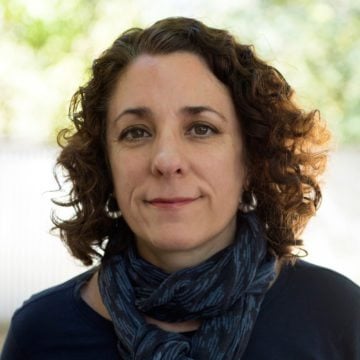
A version of this story ran in the March 2015 issue.
Above: A Texas Department of Public Safety training exercise near McAllen.
The pickup truck accelerated. Jose Isabel Coj Cumar could see the glow of the sun through the thin black fabric that concealed him and the five other men in the bed of the truck. They lay staggered side by side, packed so tight Jose Isabel could scarcely move. The truck swerved then drove faster, and now he heard the wail of a siren and understood they were being pursued. His heart began to race. Then a sound like rocks pelting the side of the truck, and a scream so terrible he felt a chill in the sweltering heat.
It was his brother, Jose Leonardo. “My foot, my stomach,” he moaned. Jose Isabel and the others pulled the fabric tighter to prevent the wind from ripping it from their hands. They held onto it as if their lives depended on it, as the smugglers had warned them to do after they crossed the Rio Grande into Texas. But now something had gone horribly wrong.
The truck swerved again but didn’t slow. There was no way to communicate with the driver. The smugglers had been in such a rush that Jose Isabel hadn’t even seen the driver’s face. It had been nearly a month since they’d left the Guatemalan highlands in early October. In Mexico, the nine men had ridden on top of the freight train La Bestia and had their backpacks stolen near the Rio Grande. When they’d arrived in Texas with nothing but empty wallets, they’d felt lucky to have made it. Just this final drive to a safe house, they thought, and then they’d be on a bus to New Jersey, where they had construction jobs waiting for them.
Now all Jose Isabel wanted was for the driver to stop. Something had happened to his brother. He could barely hear Jose Leonardo over the deafening noise of the speeding tires on the dirt road, and now a strange sound engulfed them. A helicopter blotted out the sun. Through the fabric he saw, above him, the outline of a soldier and the thick barrel of a gun.
Capt. Stacy Holland maneuvered the helicopter closer as the pickup sped east down Sevenmile Road toward the small South Texas town of Peñitas. The shooter, Miguel “Mike” Avila, had already shredded its rear tires with at least 18 shots from a rifle. A plume of dust billowed in its wake. The truck fishtailed, but it didn’t stop.
“Johnny, you think it looks good? We can give it to him again on the front left,” said Holland to the helicopter’s co-pilot, Lt. Johnny Prince.
“Try and hit a tire, Mike,” Prince said. Avila sat in the open door of the helicopter steadying his rifle.
“Game warden, we’re going to go hot. Give us some room. Give us some room. We’re gonna go hot after the front tire,” Holland radioed to the wardens pursuing the truck on the ground.
A shot rang out.
“You got it,” Prince said.
This time the truck lurched to a stop on the side of the caliche road. The driver and four men bolted from the truck, hurdling a barbed-wire fence toward the open ranchland.
“Oh shit,” Avila said, as the men scattered through the brush, making one last desperate bid for escape. The helicopter crew had thought the truck was carrying drugs.
“Fuckin’ IA’s,” Prince said.
“Look in the bed,” Avila said.
In the truck, Jose Isabel watched the men run. He was still gripping the edge of the black blanket, now soaked in blood. Next to him was his brother, bleeding from gunshot wounds in his stomach and legs. He could see that two other men had also been shot. Bullets had pierced Marcos Antonio Castro Estrada’s skull, and he wasn’t moving. Vitalino Hernandez had been shot in the shoulder and back. They waited in the sweltering heat to see what would happen next.

The black and white helicopter circled over the disabled truck. Avila, in his camouflage tactical gear, sat in the open door of the helicopter holding his LaRue OBR rifle. It was a late October afternoon, and the temperature had soared into the mid-90s. A game warden chased after the men who had fled. Another warden stood in the bed of the disabled truck, telling Jose Isabel and the others not to move.
“Tell them to check the status on the bed,” Avila told Holland again.
The game wardens had called in the helicopter after the truck’s driver failed to signal a right turn in the border town of Sullivan City, according to a Texas Parks and Wildlife incident report. When the wardens hit their siren and the truck didn’t stop, a high-speed pursuit began.
“Game warden, can you copy, 108? Is there any injuries in the vehicle?” Holland radioed. The wardens didn’t answer.
Holland radioed headquarters. “Weslaco, you better get us an ambulance on standby just in case.” As the helicopter circled, the local police arrived on the scene. Holland tried to radio them for an update on the men in the truck, but the La Joya Police Department didn’t have mobile radios that could communicate with the helicopter. About 15 minutes after the first shot, with no news on whether the men were alive or dead, the chopper landed, kicking up a storm of sand that billowed over the road. “Mike, go check it out and tell them we can air evac if need be,” Holland shouted. Avila jumped from the helicopter and ran toward the pickup.
DPS helicopter video of the pursuit. See the full video here.
Mike Avila, the shooter, wasn’t a soldier, or a federal agent with Border Patrol; he was a state police officer with the Texas Department of Public Safety (DPS). On Oct. 25, 2012, in the outskirts of the border town of La Joya, local and state police responded within minutes to the shooting. The disabled Ford F-150 extended cab truck was riddled with bullet holes, three of its tires ripped to shreds. In the bed of the truck, Marcos Antonio Castro Estrada, who had been struck in the head, was already dead. Jose Leonardo Coj Cumar, Jose Isabel’s elder brother, had a massive wound in his right leg near his femoral artery. Vitalino Hernandez, who had been shot in the shoulder and back, wept for Castro Estrada, his brother-in-law. Of the three wounded men, only Hernandez would survive.
In the wake of the shooting, the American Civil Liberties Union and other civil rights groups demanded an independent investigation. Border legislators and residents were outraged to learn that DPS marksmen in helicopters were shooting out the tires of suspected drug smugglers as part of an aggressive drug interdiction strategy in their communities. The Ford F-150, driven by a 14-year-old from Mexico, contained no drugs or weapons, just nine undocumented men hidden in the cab and bed of the truck. After the incident, DPS conducted an internal investigation, but refused to release documents or video related to the incident, despite requests from news organizations and the ACLU. A Hidalgo County grand jury was convened to investigate, but the evidence presented was also kept from the public. The Observer has obtained a copy of the 22-minute helicopter video and other evidence presented to the grand jury, allowing for a fuller understanding of the events that led to the fatal shooting.
Six months before the October 2012 incident, Discovery Channel aired a documentary called Texas Drug Wars. In the 45-minute broadcast, DPS makes its vision for border policing clear. “We’re not going to give up one square inch of this territory,” says Stacy Holland, captain of the DPS aviation division. “We’re using tactics and equipment that you will see in war zones.” To demonstrate, a DPS tactical officer, perched in a helicopter with a rifle, aims at a suspected drug smuggler’s truck as it careens along a busy highway in South Texas. “If you don’t believe in border security, you will,” says a voice-over, “because it’s coming to a town near you.”
Millions of residents who live along the border in California, Arizona, New Mexico and Texas are policed by a growing number of federal agents, including U.S. Customs and Border Protection (CBP), which is part of the Department of Homeland Security. CBP flies drones over the region, and its Border Patrol agents oversee highways and operate checkpoints within a 100-mile-wide corridor along the international boundary. Texas, which claims the largest swath of the border with 1,254 miles, has more than 10,500 federal Border Patrol agents, some of whom patrol the Rio Grande by boat and are heavily armed. In recent years, they have come under increasing criticism for excessive use of force, including incidents where agents have shot and killed unarmed civilians on the Mexican side of the border. Last year, in response, the Border Patrol announced new, more restrictive policies related to use of force.
But the use of military tactics by a state law enforcement agency like DPS was new, the product of an aggressive stance by former Texas Gov. Rick Perry, who stepped down in January after serving 14 years in office. Perry first declared border security a priority in 2005, during his second term, in the lead-up to his 2006 reelection campaign. Perry wanted to remake the Texas Department of Public Safety—whose five law enforcement divisions include the Texas Highway Patrol, the Texas Rangers, and an aircraft unit—into his own Texas-style homeland security agency. DPS, especially its iconic rangers with their white cowboy hats, often played a starring role in bolstering Perry’s political ratings during his three successful gubernatorial races and his bid for the White House in 2012. With the rangers at his side, Perry often boasted of Texas’ border security know-how and criticized the Obama administration’s security strategies along the border.
“We’re not going to give up one square inch of this territory. We’re using tactics and equipment that you will see in war zones.”
Much of the agency’s transformation has been the work of Steve McCraw, a retired FBI agent hired in 2004 to serve as Perry’s homeland security advisor and then appointed in 2009 as director of DPS. Since he took over the agency, with its more than 3,500 law enforcement officers, DPS has transformed into a police force equipped with military weaponry and a military mindset, obsessed with crime along the Texas-Mexico border. Unrest in Mexico has only escalated the militarization. McCraw has spent millions on drug interdiction along the Rio Grande, and acquired weapons provided by the Department of Defense’s 1033 program, which diverts surplus military equipment from the wars overseas to domestic police. In recent years DPS has received several M-16 and M-14 rifles through the program, as well as a Huey helicopter, two Mine-Resistant Ambush Protected vehicles, and two Commando V-150 armored cars, according to public records available on MuckRock.com. The agency also spent $3.5 million on six armored gunboats with .30-caliber machine guns to patrol the Rio Grande and $7.4 million on a high-altitude spy plane. And it began to refer to operations along the border in military terms, engaging in “surges” and “Ranger Recon missions,” yet providing little proof to elected officials that its new militarized strategy was working.
Besides the heavy weaponry, DPS has also increasingly focused on intelligence gathering. In the last decade, the agency has invested millions in state and federal funds to create six Joint Operations Intelligence Centers and form its own counterterrorism and intelligence division, with little input or oversight from the state Legislature. And the agency has compiled information on citizens, including biometric data, for an expansive database called TDEx.
Mike Avila’s career at DPS unfolded as the agency’s profound transformation was underway. Avila started out in 2002 in the Highway Patrol, then became a K-9 trooper in South Texas, and ultimately worked his way up to becoming a tactical flight officer in 2010 with the agency’s aircraft division, according to his personnel records. By December 2011 he was ranked a “designated marksman.” In May 2012 he received eight hours of tactical firearms training. In his performance evaluation that year, supervisors rated his skills as “meets expectations” and noted that he “exceeded expectations” in accepting direction, job knowledge, work attitude and initiative. He also won special praise for assisting leadership with “several high profile media projects that have represented the department well.”
But even as DPS was encouraging Avila and others to promote the agency as an elite fighting force in television shows like Texas Drug Wars, the need for such a force was unfounded. Drug busts and migrant apprehensions along the border—with the exception of an influx of Central American asylum seekers—were not spiking. In fact drug busts were about to begin a steep decline, and FBI crime statistics showed that Texas’ border communities had some of the lowest murder and violent-crime rates in the state. After the 2012 shooting in La Joya, border residents already skeptical of the DPS hype became alarmed. National experts on policing were also troubled. “What if you hit the driver? Then you’ve got an unguided missile on your hands,” said University of South Carolina professor Geoffrey Alpert, a national expert in police pursuits. “What they were doing was totally crazy.” No other domestic law enforcement agency in the country allows its officers to shoot at moving vehicles from a helicopter.
On the morning of Nov. 14, 2014, I set out for the small village of Varituc del Carmen in the western highlands of Guatemala to meet Jose Isabel and his family. It takes more than an hour to reach Varituc from the city of San Martin Jilotepeque on a kidney-rattling road along high mountain cliffs. Along the way we pass a giant white cross that commemorates 48 lives lost after a passenger bus careened over the side of the mountain. This is the territory of the Kaqchikel Maya, who have lived here since before the Spanish Conquest. The mountains are lush with pine forests. A volcano ringed by white clouds towers over the green valleys. But my hired guide Mariana (not her real name; she requested a pseudonym due to fear of political repercussion), a 48-year-old Kaqchikel community leader, reminds me that Guatemala’s beauty can be deceptive. This region saw some of the most brutal violence after a CIA-backed military coup in 1954 plunged Guatemala into a decades-long civil war. During the war, the Guatemalan army, at times with military aid from the United States, massacred the Kaqchikel and other indigenous tribes as part of a strategy to root out Communist influence in Central America. There are still mass graves among the pine forests and cornfields, and bodies are being slowly exhumed and identified by the Forensic Anthropology Foundation of Guatemala.
Sitting in the back of the van on the way to Varituc, Mariana radiates a calm dignity. She wears her long black hair in a braid and a traditional red and blue woven skirt and a colorful embroidered shirt. “The war ended but the violence continues,” she says. The country’s indigenous people are still persecuted by the military and the police, she says. In Guatemala there are two worlds: One belongs to the indigenous Maya, who are poor and have little access to food or education, and the other belongs to the non-indigenous elite, who control the country’s wealth. In the 1980s, Mariana tells me, she lost an older brother and three cousins in the war. Later, she discovered that the army had taken her brother, who had been a member of a resistance group. Since his disappearance, Mariana has devoted much of her time to helping others work through their trauma and loss.
The mountain villagers practice self-governance, Mariana says, because the Kaqchikel can’t trust the government. She has secured permission from village leaders to enter Varituc del Carmen and another village called Pachay Las Lomas, where the parents of Marcos Antonio Castro Estrada live. We will have to be out by dusk, she says, because at night members of the security forces and organized crime roam the dark mountain roads and our safety cannot be guaranteed.
After our van arrives at a small yellow and white church in Varituc, we hike up a long dirt path through banana groves and cornfields into the mountains. Finally we arrive at two modest homes, one brown adobe and the other gray concrete, where Jose Isabel’s parents and large extended family live. His parents, Cristina, 63, and Raymundo, 72, stand at the entrance, and Mariana greets them in Kaqchikel. They stare at my husband, holding his camera, and me with suspicion as Mariana explains that we have come all the way from Texas to speak with them.
“What good will it do?” Jose Isabel’s father asks us in Spanish. “Our son is dead.” His shoulders slump and he looks at the concrete floor. Cristina begins to cry. Mariana pulls a white candle from her woven bag and explains that it is an offering to the departed soul of Jose Leonardo. She lights it. “Jose is here. He is with us,” she says, placing the candle on a stool. Cristina stares at its flame and wipes the tears from her cheeks.
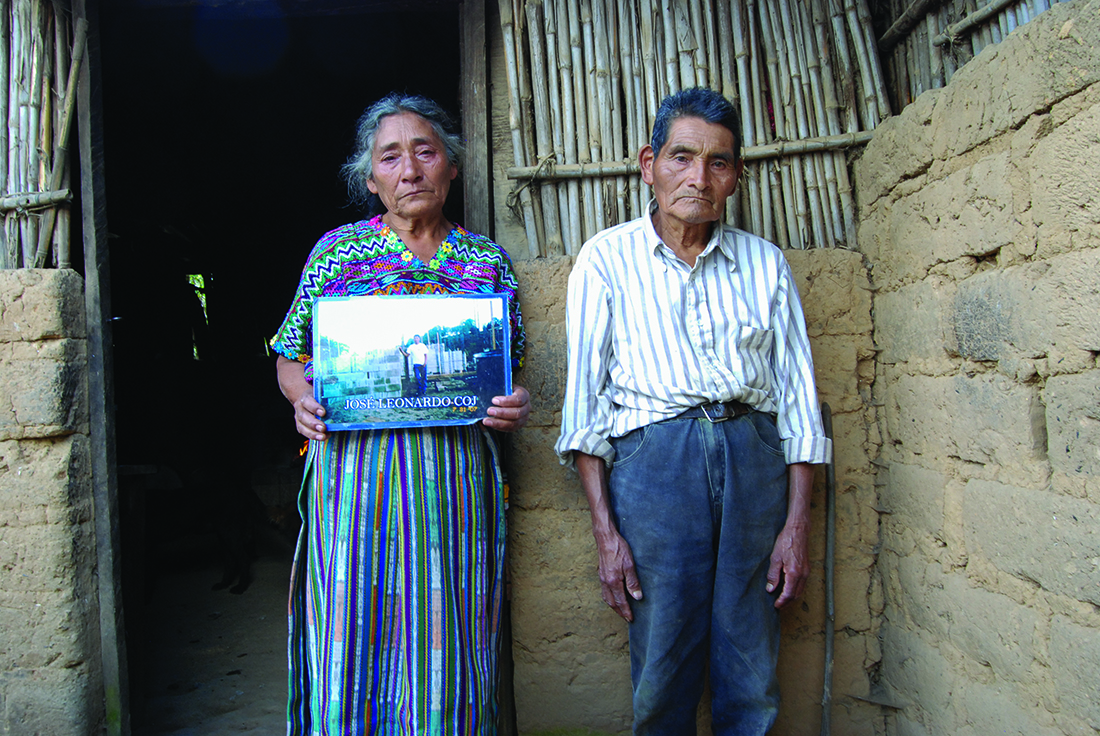
When Jose Isabel arrives, with his wide handsome features and dark brown eyes, I recognize him immediately from the police video and photos. He is nearly 2 feet taller than his parents, dressed in jeans and brown cowboy boots. His parents seem worn out, physically diminished by deprivation and heartbreak, but Jose Isabel still has an openness, or perhaps it’s hopefulness, about him. He greets us with a handshake. At 28 he is the youngest in a family of 10 children. He has a 4-month-old son, his first child, he explains with a shy smile. He helps his father set up chairs for us on the patio. Children gaze at us curiously, then laugh and run away only to return giggling again. Jose Isabel’s grandmother, who speaks only Kaqchikel, sits silently in a corner watching us, her face impassive. “How do we begin?” Jose Isabel asks in Spanish.
“From the beginning,” I say. He describes the long journey, then the waiting in the South Texas brush after hiking along the Rio Grande for seven hours. It had been Jose Leonardo’s idea to go and Jose Isabel had agreed. His 33-year-old brother had three children and a wife to support. In the ’80s, during the war, the schools had been destroyed, and with them any chance for an education. Working in the fields paid $4 a day, sometimes less. When the brothers tried to imagine a future in Varituc, it didn’t add up. In the past decade, many men they knew had made a similar calculation. A friend, already in the United States, said there were good-paying construction jobs in New Jersey waiting for them. A local network of moneylenders and smugglers seemed to offer the only hope.
Not that it was cheap. Jose Isabel and his brother each paid $6,000—a fortune in their village—for the trip to New Jersey. Their parents put up their land and home as collateral on a $12,000 loan to pay the smugglers. In the United States, they would pay off the debt in a year, maybe two at the most, they reasoned.
When Jose Isabel comes to the part about the helicopter and its aftermath his voice falters, and I see in his face that he is back with his brother on Sevenmile Road. His father looks away, blinking.
“It was like a dream,” Jose Isabel says after a long pause. “When I saw my brother like that, and my compañeros, I didn’t feel anything anymore.”
“Why didn’t you let go of the blanket so the helicopter could see you?” I ask. After the shooting, this had been one of the burning debates among elected officials: whether the blanket had partially blown away, making the men visible to Avila, the DPS marksman. A group of state legislators had viewed the DPS helicopter video privately and determined that the men were never visible. So there was no way Avila could have known that the truck was hauling undocumented immigrants, not drugs as the game wardens and DPS helicopter crew had thought.
“We were too scared,” Jose Isabel says. “I never imagined that in the United States they would treat people this way. If we had had weapons it would have given them cause. But we had no drugs, no weapons. We were only coming to work.”
“I never imagined that in the United States they would treat people this way. If we had had weapons it would have given them cause. But we had no drugs, no weapons. We were only coming to work.”
At first he hadn’t realized how badly his brother was hurt. After the truck stopped, Jose Leonardo sat up and spoke a few words. “He told me, ‘I feel really hot. Could you please take off my boots?’ I used my baseball cap to fan him,” Jose Isabel says, “and I gave him water, but after that he didn’t say anything anymore.”
The men waited at least 30 minutes for an ambulance, according to DPS audio obtained by the Observer. Though the helicopter’s video shows that Avila eventually ran toward the truck to offer aid to the injured men, Jose Isabel says he never saw Avila nor heard anyone offer to transport them by DPS helicopter. A Medevac helicopter arrived 20 minutes after the DPS chopper landed. “The police only checked us for weapons, but we didn’t have anything, only an empty jug. We had already finished the water,” he says. Firefighters from the local volunteer fire department attempted to treat the men. There was nothing they could do for Marcos Antonio. An ambulance took Vitalino, who was the least seriously wounded of the gunshot victims. The Medevac helicopter from the trauma hospital, which was 17 miles away, airlifted Jose Leonardo, who was losing consciousness.
“He was still alive, but it was very serious. I was desperate,” says Jose Isabel. By then there were several Texas Rangers, DPS troopers, Border Patrol and local police officers at the scene. “I asked to go in the helicopter with him, but they wouldn’t let me,” he says. “They told me, ‘Don’t worry.’ Then they locked us up in a place where it was very cold.”
The cold place was a holding cell at the nearby McAllen Border Patrol headquarters, which immigrants refer to as la hielera, the icebox, because the cells, which have no beds or chairs and only one exposed toilet, are kept at near-freezing temperatures. Jose Isabel waited in the cell along with the rest of the men who had fled the truck and been detained within minutes. The 14-year- old driver had already been deported because he was a minor from Mexico. After about five hours, a dazed Vitalino arrived, still in his hospital gown, with his gunshot wounds hastily bandaged. In police video, two rangers begin to interrogate Vitalino about his trip and why he had come to the United States.
At 10:30 p.m., nearly seven hours after the shooting, it was Jose Isabel’s turn to be questioned. One of the rangers holds up Jose Leonardo’s identification card for the camera. “Is this your brother?”
Jose Isabel nods. Then the rangers begin to question him about his journey and the DPS helicopter. After 25 minutes, one of them asks Jose Isabel if he has any questions.
“Can you tell me about my brother … how is he?”
“You don’t know what happened to your brother?” asks one of the rangers. There’s a long awkward silence. Jose Isabel can see the answer in their faces.
“We will let you know when we have verification,” says the other ranger.
“At that moment I was destroyed,” Jose Isabel tells me. “I only wanted to get away. Afterward I asked the guards, ‘When are you going to deport me?’”
But the guards didn’t deport Jose Isabel. Instead they sent him and the other men to a detention facility near Brownsville, where they remained for the next seven months. Three months after the shooting, the mayor of San Martin Jilotepeque traveled to Guatemala City to collect Jose Leonardo’s body. Jose Isabel never got to say goodbye. “I feel this great void,” he says. “How can I explain it in words?”
His mother begins to sob again. “I still remember my boys as children here with me,” she says, motioning at the air as if she were patting the top of one of the young boy’s heads. “When the soldiers came to our village they burned our houses. They threw children into the fires. People said, ‘Here come the ones from hell,’ and I gathered up my children and took them away from here,” she says. “We survived. We suffered a lot but we survived and nothing happened to my children. Nothing until now, and because he was looking for work, they took his life.”
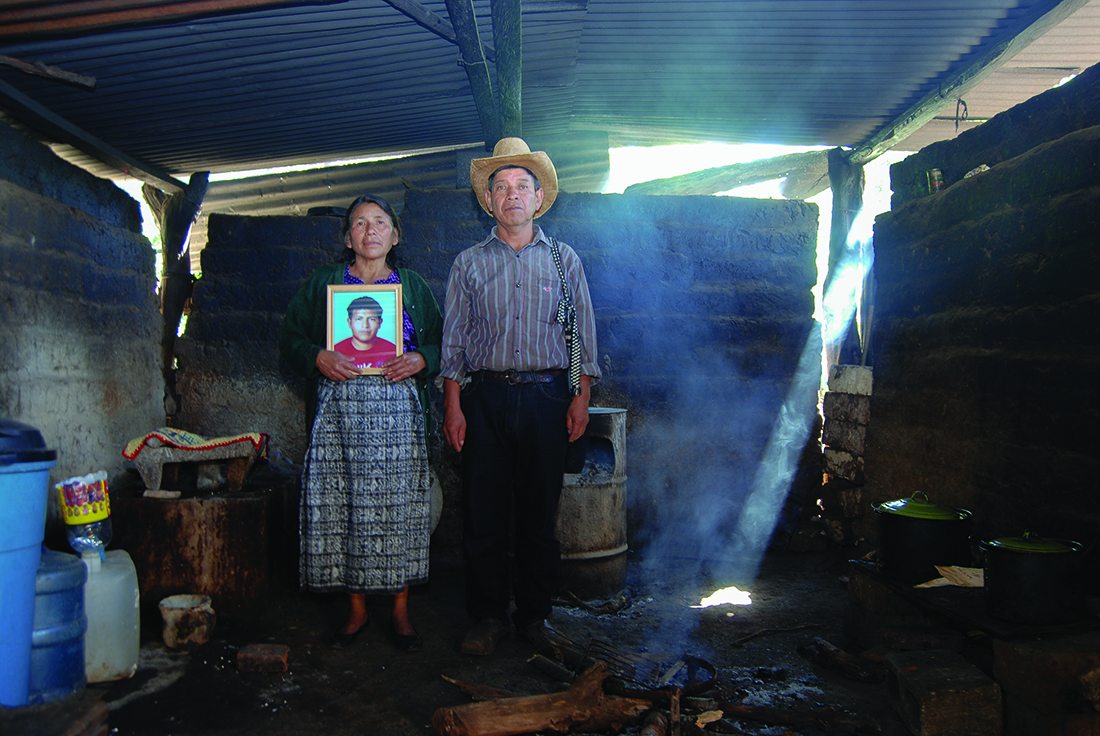
In Kaqchikel, the word “Pachay” means “among stones of obsidian,” and the next morning, as we drove up the narrow mountain road toward the village of Pachay las Lomas, pieces of black obsidian, some as large as a jaguar’s head, glistened in the parched white riverbed below. The small village of little more than 2,500 had once been a model of community organizing; the poor subsistence farmers who lived there had formed land cooperatives and organized to demand schools and health clinics from the government. The disappearances and murders of the community’s leaders in the 1980s by the Guatemalan army had put an end to the experiment. Now the elderly try to scratch out a living on their small patches of land while their children search for work in Guatemala City and beyond.
Marcos Antonio Castro Estrada, who was 29 when he died, grew up here as the eldest of seven children. He worked in a Korean-owned factory in Guatemala City, sewing pants and jackets. But the salary wasn’t enough to provide for his wife and two daughters, ages 3 and 1, says his father, Marcial Castro, who receives us in front of his simple brown adobe home. His wife, Maria Dorotea, who wears a traditional purple embroidered huipil and a woven skirt, speaks only Kaqchikel. Mariana greets her in their native language and the two begin to speak in rapid melodic sentences. Maria Dorotea begins to cry. Mariana produces another white candle from her woven bag, lights it, and places it on the cement floor. Maria Dorotea sinks to her knees with tears streaming down her cheeks and begins to rock back and forth, praying and calling out to her son. Marcial blinks back his own tears.
“He lived here next to us,” Marcial says, pointing to a small concrete block home next door. “There are days when one feels a little better and days when we feel broken inside. We feel only pain.” Now the house is empty, Marcial says, and Marcos Antonio’s wife has taken their two grandchildren to live with her parents. She was five months pregnant when she got the news he’d been killed. “She lost the baby,” Marcial says. “She stayed in her house sick for two months afterward.”
Like the other villagers in Pachay, Marcial and Maria Dorotea grow corn and other subsistence crops. In winter, the family migrates to the coast to cut sugar cane. “We have to go far away just to get a little bit of money,” he says. “And sometimes there is no work at all.” Marcos Antonio’s goal was to make enough money working in the United States to buy a small plot of land in Pachay to farm. “My son was a hard worker, but we don’t have an opportunity here to obtain a degree and get a job that can offer one a life,” Marcial says. “We farm just so we can eat. No, it is impossible to live like this. And so he decided he would leave.”
Maria Dorotea, who had left to compose herself, returns with a framed portrait of her son. “I look at him and think he is not dead,” she says in halting Spanish. “My son, the eldest. The one who died.” She hands me the portrait. It especially bothers them that the Guatemalan media reported that Marcos was killed because of drugs. “They opened fire on him because they thought he was carrying drugs,” Marcial says. “But it’s not like that. He was only looking for work. What we ask for is justice. His children are still little. They have no food, no support. But what can one do from here? I don’t have a passport. There is no money to travel and find the truth. Nothing can be done.”
On Sept. 10, 2013, a Hidalgo County grand jury declined to indict DPS officer Mike Avila on criminal charges of deadly conduct. “It was poor judgment,” says Rene Guerra, who was district attorney for Hidalgo County at the time. “But there’s no way he knew there were people under the blanket.” The Texas Rangers investigated the shooting, but DPS has refused to release its findings despite several open records requests from the Observer. Requests for interviews with DPS Director Steve McCraw and Avila also were denied. The FBI finished its investigation in 2014 and came to a similar conclusion as the grand jury: Avila was just doing his job. The U.S. Department of Justice Civil Rights Division responded to an open records request from the Observer with an email saying the department was “currently reviewing records collected related to this incident” and had yet to generate a report.
After the 2012 shooting, it became clear the agency had no policy regarding the use of deadly force from a helicopter. Elected officials in the region, it turned out, had not even been notified that state police in helicopters were now shooting out the tires of vehicles as part of a drug interdiction strategy along the border. The incident attracted enough attention that DPS eventually announced a change in policy to prohibit troopers from shooting to disable vehicles if they are unaware of the “status of occupants in addition to the driver.” Now tactical officers in helicopters can shoot only if law enforcement on the ground is “unavailable or incapable of responding to the threat in a reasonably effective manner.” The agency also, for the first time, implemented a use-of-force policy for its armored gunboats on the Rio Grande.
In the past, there have been indications that agents’ claims of taking fire on the Rio Grande from Mexico are sometimes exaggerated. In 2011, DPS troopers on a boat fired more than 300 rounds into Mexico, claiming they had come under “heavy fire.” After the media questioned the allegation, DPS Director McCraw revised the story, saying that more than “four shots from Mexico” were fired in the direction of his agents. And in July 2013, according to a Texas Rangers report obtained by the Observer, four rangers in full tactical gear and body armor launched flashbang grenades into Mexico and fired at least 150 rounds from a belt-fed machine gun and rifles after a ranger said he “heard and felt at least two rounds fired” from the Mexican side of the river. According to the report, one sergeant on board said he was unsure whether the gunfire he’d heard had come from Mexico or from the ranger standing next to him on the boat. “All efforts to locate gunshot victims, weapons, or evidence on the Mexican side of the Rio Grande yielded negative results,” the report concluded.
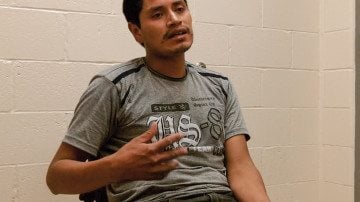
State Sen. Juan “Chuy” Hinojosa, who represents the border county where the October 2012 shooting occurred, is a former Marine who fought in Vietnam. (I once served as his communications director at the Texas Capitol.) Other than a stint at law school in Washington, D.C., and his time overseas during the war, Hinojosa has lived on the Texas border his entire life. The average household income in the region is below the state average. But the region’s fortunes are changing. It’s one of the fastest-growing areas in the state, with a flourishing economic sector thanks to Mexico, the state’s top trading partner. In the next few years, Hinojosa’s district will be home to a new medical school, and at the nearby coast a company called SpaceX, founded by entrepreneur Elon Musk, is scheduled to open a rocket launch site for private space travel. Still, the border region, which leans heavily Democratic, is plagued by low voter turnout and has little influence in the Republican-led Texas Legislature or with Texas’ Republican governor.
Before October 2012, Hinojosa was unaware that DPS was shooting from helicopters in his district. “To me, it was the wrong policy to be shooting from a helicopter at a moving vehicle when you don’t know who or what is in the vehicle,” he says. “I know from my experience in Vietnam that it’s kind of tough to hit a moving vehicle when you are in a helicopter.”
After the incident, Hinojosa, a Democrat, called for a legislative review of DPS policies. Director McCraw went on the defensive, saying in a press release that the truck had been speeding toward two schools less than 3 miles away and therefore posed “an immediate threat to the school children and motoring public.” Former state Rep. Sid Miller, chairman at the time of the House committee overseeing DPS, said a review of the agency’s policies was unnecessary. “There’s no need for a hearing,” Miller, a Republican, told the Houston Chronicle. “In this case it was definitely warranted. We don’t go around willy nilly shooting people, but the litmus test is if you’re endangering the lives of other people, we will shoot you.”
The border has its share of law enforcement challenges, Hinojosa acknowledges, sitting in his office at the Capitol. For many years, he has used his position as vice chair in the powerful Senate Committee on Finance to advocate for more resources for DPS. But he now believes the presence of National Guard soldiers and an overly militarized DPS is doing more harm than good. “We have a problem, obviously,” Hinojosa says. “There is human smuggling and drug trafficking coming in from Mexico, and ammunition and guns flowing back into Mexico. The presence of DPS and law enforcement can act as a deterrent. But we’d be better off with some Texas Rangers who actually investigate crime.”
While Congress fails to move on immigration reform, he says, there are also public officials building up scary and negative images of what’s happening on the border. “This creates this state of mind that we’re in a war zone,” Hinojosa says. “And instead of using tactics appropriate for a community, they use tactics appropriate for a war zone.”
What’s especially insulting, he says, is that the public officials leading the militarization of the border don’t live in border communities or consult with residents: “It would be very helpful, even constructive, if they spoke with people who live at the border, people who work there, who shop there and who raise their families there. There would be better results. But I don’t think that’s what they are looking for.”
When Perry decided to transform DPS into a homeland security-style agency, the state lacked the expertise and personnel to make it happen. So it contracted with a Virginia-based consulting firm called Abrams Learning and Information Systems Inc., or ALIS, founded in 2004 by retired Gen. John Abrams, former head of the Army’s Training and Doctrine Command.
From 2006 to 2012, Texas paid nearly $20 million in no-bid contracts to ALIS to help develop its border security plan, according to the Austin American-Statesman. An investigation by the paper lays out the breadth of ALIS’ role along the border in stark terms: “The firm brought a military sensibility to border operations, supporting ‘surges’ of local and state law enforcement and helping to form Texas Ranger Reconnaissance teams, units that operate along remote areas of the border. ALIS also helped to set up joint intelligence centers in cities along the border, where military-style ‘joint’ commands of local, state and federal law enforcement come together.”
In August 2010, DPS paid ALIS $1.4 million to develop a media outreach strategy to “position Texas border security efforts in a positive light.” Abrams created talking points for state leaders featuring several key messages, including, “Border security is a federal responsibility but a Texas problem,” a sound bite Perry often used during his 2012 presidential campaign.
If the Texas border has become a war zone, then the men who died on Oct. 25, 2012, were the war’s first known casualties.
A tactical training firm, Craft International, trained some of the agency’s tactical flight officers. The company was co-founded by the late Chris Kyle, a former U.S. Navy Seal and subject of the Clint Eastwood movie American Sniper. At the time of the October 2012 shooting, Craft International had a training video on its website featuring Texas state police in tactical gear firing from DPS helicopters to a heavy metal soundtrack. (The video has since been removed.) DPS spokesman Tom Vinger wrote in an email to the Observer that Avila was not trained by Craft International; Avila received his training from DPS instructors, who have incorporated the Craft training into their own curriculum.
In 2011, DPS and Todd Staples, then Texas Department of Agriculture commissioner, paid two other retired generals, Barry McCaffrey and Robert Scales, $80,000 to produce a report making the case that spillover violence from Mexico required increased federal funding for Texas law enforcement. McCaffrey had served as commander of U.S. troops in Central and South America in the early 1990s as the war in Guatemala was winding down. He later served as drug czar under President Bill Clinton. In 2003, Scales co-founded a private defense-consulting firm called Colgen Inc. In 2008, The New York Times revealed that Scales had been part of a covert group of retired military officials advocating in the media on behalf of the Bush administration for the invasion of Iraq.
On Sept. 26, 2011, nearly a year before the shooting in La Joya, the two generals released their report with a press conference at the Texas Capitol. They were surrounded by Republican legislators including U.S. Congressman Mike McCaul, state Rep. Sid Miller and Staples, who stood alongside several Texas border sheriffs who had received funding through the ALIS-designed Operation Border Star, the state’s border security plan. The 59-page report, citing mostly anecdotal evidence and media reports, criticized the federal government for its failure to protect the border and lauded Perry’s “Texas homeland security team,” calling Texas a “laboratory for a national effort.” The report didn’t mention that much of Texas’ strategy was the work of ALIS. In their report, McCaffrey and Scales also hyped a new terminology, “narco terrorism,” which was rapidly gaining favor with border war hawks in Washington, D.C. By creating a hybrid of the “war on terror” and the “war on drugs”—two costly U.S. wars with no clear enemy or end in sight—“narco terrorism” would guarantee not only more federal spending but also more military intervention. The generals’ report concluded: “Living and conducting business in a Texas border county is tantamount to living in a war zone in which civil authorities, law enforcement agencies as well as citizens are under attack around the clock.”
If the Texas border was a war zone, as the generals claimed, then the men who died on Oct. 25, 2012, were the war’s first known casualties.
La Joya police officer Ramon Gonzalez and his partner were the first officers to respond to the shooting on Sevenmile Road. La Joya, with a population of little more than 4,000, is 98 percent Hispanic and predominantly low income. It’s just a short drive from town to the Rio Grande and Mexico. Gonzalez says the game warden who called in air support made an understandable mistake, as it’s common practice to transport drugs that have just crossed the river in the beds of pickup trucks beneath tarps or wooden covers. It’s also common to transport undocumented immigrants the same way.
Gonzalez says it was around the time that Discovery Channel showed up to film Texas Drug Wars that he became aware of DPS choppers shooting out the tires of vehicles in his jurisdiction. DPS records show officers had fired from helicopters on seven occasions beginning in September 2010, when a DPS helicopter and SWAT team were called in after a Republic of Texas militia member shot two law enforcement officers and a civilian in a standoff in the West Texas town of Odessa.
After the Odessa incident, DPS shifted to the border. Five of those events, including the fatal La Joya incident, took place near the border in pursuit of vehicles with suspected drug loads.
But only twice did DPS shooters actually hit a tire. One of those occasions resulted in the deaths in La Joya, and the other in a suspect taken into custody. In the scene highlighted in Texas Drug Wars, the shot fired by the tactical officer, according to DPS records, never hit the vehicle, which was speeding down a crowded expressway. Three of the five pursuits yielded bales of marijuana plus “one baggie of cocaine and one open beer.”
After the fatal October 2012 shooting, DPS stopped shooting from helicopters during pursuits. But DPS tactical officers are still trained to shoot from helicopters. In August 2014, in the small Central Texas town of Hillsboro, a DPS helicopter shooter fired at an armed man who had burned down his neighbor’s house and fired at law enforcement. The man was taken into custody uninjured.
In Officer Gonzalez’s 2012 La Joya incident report, he notes that his unit was en route and ready “to assist and deploy [tire] spikes if needed”—a far safer tactic that probably would have prevented the deaths. But by the time he and his partner rolled up to the truck, it was already disabled on the side of the dusty farm road. “It was hot that day, and I told them to take off the blanket and get some air,” Gonzalez says of the men in the back of the truck. It was quickly obvious that something had gone terribly wrong. “Their eyes were in shock, and no one wanted to speak with me. I had to be firm and stern and say ‘Is everyone OK?’ And at that point one of them answered in Spanish, ‘The military shot us.’ And I said, ‘What do you mean the military shot you?’ And he pointed up to the helicopter and that’s when I put two and two together.”
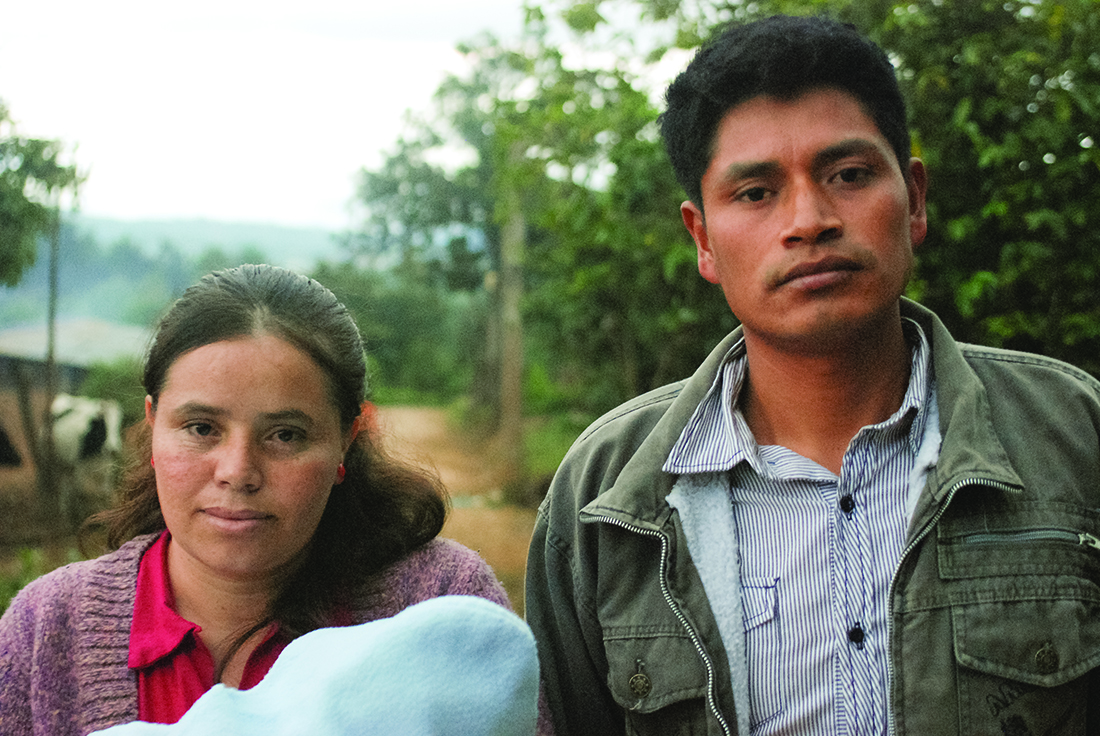
When Jose Isabel and I talked in Varituc, I sensed there were things he didn’t want to say in front of his elderly parents. So I arranged to meet him again, this time in Guatemala City, about three hours from Varituc, where he and his siblings spend much of their time searching for work. One of the more striking things about gray and industrial Guatemala City is the number of U.S. fast-food chains that dot the landscape. We met in a gleaming white two-story McDonald’s beside a busy highway. Around 7 p.m., Jose Isabel arrived outside with his elder brother Efren. Both men, still in their work clothes, looked exhausted, their eyes bloodshot from painting the interiors of an apartment building since early morning. The brothers scrunched their baseball caps tightly in their hands and seemed uncomfortable with the notion of entering a McDonald’s. Inside, a middle-class family celebrated a birthday with pink balloons and a man in a business suit heartily dug into his Big Mac. I bought us coffees, which cost nearly half a day’s wage for the men, who typically make about $10 a day—when they can find work. Fleeing the rowdy birthday party, we found a table upstairs where we could talk.
“What will you do now?” I asked Jose Isabel.
“I don’t know,” he said, staring into his coffee. He said he still owed more than $6,500 to the moneylender who financed his trip to the United States. The debt, at 8 percent interest, had rapidly accrued while he was locked up at the detention facility in Texas. If he didn’t pay, the moneylenders would take his family’s home and land. After his brother’s death, they’d paid a visit to Varituc to collect on the debt.
“Will they take your home by force? Will they come armed?”
“No,” he said. “They’ll come with lawyers.” Somehow, his parents had been able to get his brother’s debt canceled, because of his death, but now the lenders hounded Jose Isabel every month for the remainder. In Guatemala City, the brothers pay $40 a month for a shared room. Whatever money is left after buying food and supporting his wife and 4-month-old son, Jose Isabel sends to the debt collector. “I am struggling,” he said. “But I’ve put it in God’s hands.”
“Will you ever be able to pay it back?”
“No. Not here,” he admitted. “It is impossible.”
The morning before, when we had entered Varituc, I had noticed a large, white, two-story stucco home with a two-car garage being built next door to his family’s home. The house was like a beacon among the simple brown adobe and concrete structures that belonged to Jose Isabel’s extended family. Now I asked him who it belonged to.
“My nephew,” he said. “He left at 21 and hired a smuggler to travel to the United States.” He made it, and has been working in a chicken-processing plant for the past seven years. Every month he sends money home to his family. “More than half the guys I grew up with are over there now,” Jose Isabel said.
Then he told me something surprising. That even with the burdensome debt and the lingering trauma of that day on Sevenmile Road, one of the men had tried again. This time, he’d made it to the United States and would be able to pay off his debt and support his family. “There are times when I become desperate,” Jose Isabel said. “And I think about trying again. But then I remember the way it all happened, and my brother. No.” He shook his head. “I really did make an effort, really tried to help my family. But in the end it was not possible.”
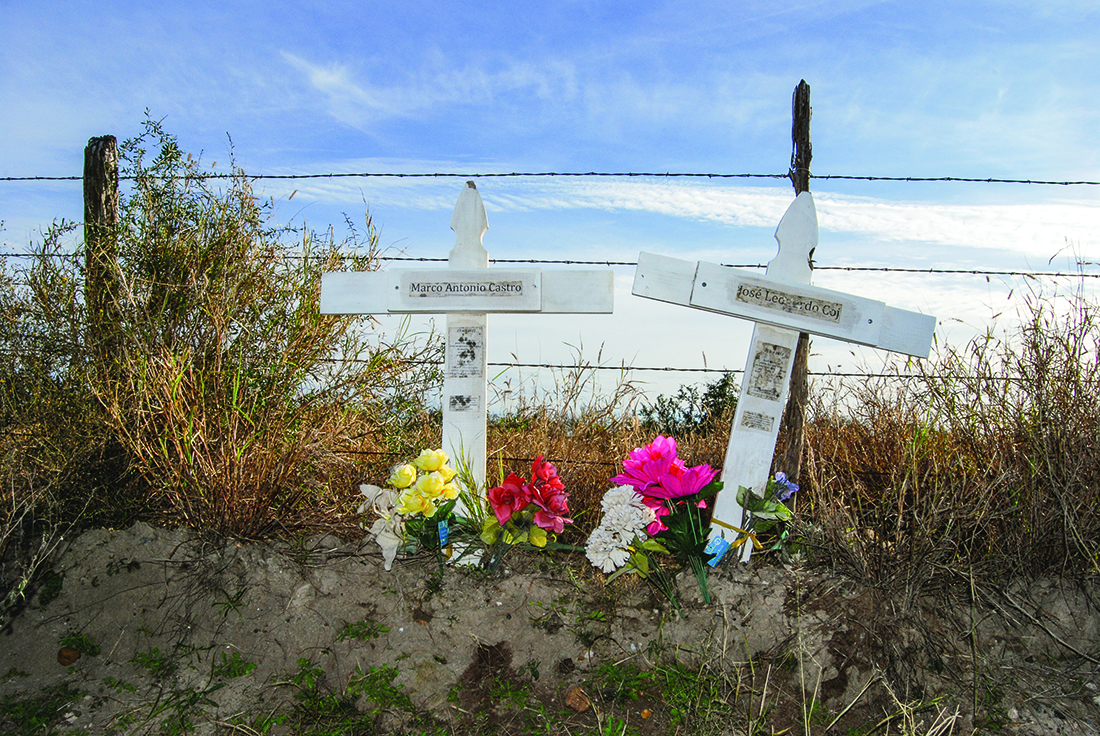
In the summer of 2014, thousands of Central Americans crossed the Texas border, many of them pleading for asylum. Many of the Guatemalans were indigenous Maya from the countryside like Jose Isabel and his brother Jose Leonardo. Guatemala has one of the highest rates of violence in Latin America, and also one of the highest rates of inequality in the world. These days, instead of military aid to fight Communism, the U.S. government sends money and soldiers to fight “narco terrorists” in an ever-expanding drug war, which has brought a new wave of violence and militarization to the region. To stem the exodus from Central America, the U.S. government is running TV and radio ads to try to dissuade people from leaving. On Mexico’s southern border, police have beaten and detained Central Americans to prevent them from boarding trains that will take them north.
At the height of the Central American exodus in July, DPS launched another “surge” called Operation Strong Safety. Armored gunboats patrolled the Rio Grande with DPS troopers, rangers and game wardens dressed in body armor and tactical gear. Texas National Guard soldiers were also deployed, despite the fact that the thousands of migrants, mostly women and children, were making a point of presenting themselves to authorities to ask for asylum. Operation Strong Safety is slated to continue into August 2015 at a cost of more than $2 million a week. Recently, newly elected Texas Gov. Greg Abbott and Lt. Gov. Dan Patrick have indicated they would like to make the surge permanent. By 2016, the state will have spent more than $1 billion in state and federal money on border security over the last decade. And it’s poised to spend much more in the decade to come.
Meanwhile, on the outskirts of La Joya, two white crosses made of wood stand on the south side of Sevenmile Road. The names of Jose Leonardo Coj Cumar and Marcos Antonio Castro Estrada are printed in faded black letters on white paper. After more than two years, weeds and brush had nearly obscured the crosses from view. At first I had driven past without even seeing them. Then a local rancher showed me where they were. He pulled the brush and weeds away from Jose Leonardo’s cross so that I could get a better look. “A faithful father died here,” it read. “He came looking for work.”
This story was reported in partnership with The Investigative Fund at The Nation Institute, where Melissa del Bosque is a reporting fellow.

